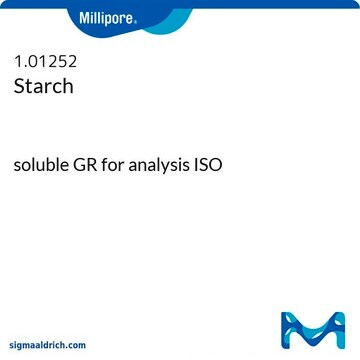1.07024
Chloroform
for analysis EMPARTA® ACS
Synonym(s):
TCM, Trichloromethane, Methane trichloride, Methyl trichloride, Methylidyne trichloride, Trichloromethane
About This Item
99.0-99.4% (GC)
Recommended Products
grade
ACS reagent
Quality Level
vapor density
4.1 (vs air)
vapor pressure
160 mmHg ( 20 °C)
product line
EMPARTA®
assay
≥99.8% (according to ACS)
99.0-99.4% (GC)
form
liquid
potency
695 mg/kg LD50, oral (Rat)
>3980 mg/kg LD50, skin (Rabbit)
dilution
(for routine analytical applications)
impurities
≤0.00003% Free chlorine
≤0.001% Aldehydes and ketones (as C3H6O)
≤0.005% Carbonyl compounds (as CO)
≤0.01% Water
evapn. residue
≤0.001%
color
clearAPHA: ≤10
refractive index
n20/D 1.445 (lit.)
bp
60.5-61.5 °C (lit.)
mp
−63 °C (lit.)
density
1.492 g/mL at 25 °C (lit.)
cation traces
Pb: ≤0.000005%
storage temp.
2-30°C
SMILES string
ClC(Cl)Cl
InChI
1S/CHCl3/c2-1(3)4/h1H
InChI key
HEDRZPFGACZZDS-UHFFFAOYSA-N
Looking for similar products? Visit Product Comparison Guide
Related Categories
General description
Application
- Novel Approaches for the Analysis and Isolation of Benzylisoquinoline Alkaloids in Chelidonium majus.: This study presents innovative techniques using chloroform for extracting and analyzing alkaloids, which could advance analytical methods in medicinal plant research (Ganzera et al., 2024).
- Preparation and optimization of dummy molecularly imprinted polymer-based solid-phase extraction system for selective enrichment of p-toluene sulfonate esters genotoxic impurities.: Focuses on a polymer-based extraction system using chloroform for purifying complex samples, enhancing the specificity and efficiency of contaminant detection in pharmaceuticals (Shan et al., 2024).
- Development of metabolome extraction strategy for metabolite profiling of skin tissue.: Discusses the development of a chloroform-based extraction protocol for comprehensive metabolite profiling, contributing to advancements in dermatological and cosmetic research (Kim et al., 2024).
- Sample Preparation from Plant Tissue for Gas Chromatography-Mass Spectrometry (GC-MS).: Details a method for preparing plant samples using chloroform for GC-MS analysis, aiming to improve the accuracy and reliability of phytochemical analyses (Kumar et al., 2024).
- Carotenoid Extraction from Plant Tissues.: Describes techniques for extracting carotenoids using chloroform, highlighting its efficiency and efficacy, which could be vital for research in plant biochemistry and nutritional science (Kumar et al., 2024).
Packaging
Analysis Note
Assay (according to ACS): ≥ 99.8 %
Identity (IR): conforms
Appearance: clear
Color: ≤ 10 Hazen
Acid and chloride: conforms
Free chlorine: ≤ 0.00003 %
Carbonyl compounds (as CO): ≤ 0.005 %
Readily carbonizable substances: conforms
Aldehydes and ketones (as C₃H₆O): ≤ 0.001 %
Suitability for determination with dithizone: conforms
Pb (Lead): ≤ 0.000005 %
Evaporation residue: ≤ 0.001 %
Water: ≤ 0.01 %
Stabilized with 0,6-1,0% Ethanol
Legal Information
signalword
Danger
Hazard Classifications
Acute Tox. 3 Inhalation - Acute Tox. 4 Oral - Carc. 2 - Eye Irrit. 2 - Repr. 2 - Skin Irrit. 2 - STOT RE 1 Oral - STOT SE 3
target_organs
Central nervous system, Liver,Kidney
Storage Class
6.1D - Non-combustible acute toxic Cat.3 / toxic hazardous materials or hazardous materials causing chronic effects
wgk_germany
WGK 3
flash_point_f
does not flash
flash_point_c
does not flash
Certificates of Analysis (COA)
Search for Certificates of Analysis (COA) by entering the products Lot/Batch Number. Lot and Batch Numbers can be found on a product’s label following the words ‘Lot’ or ‘Batch’.
Already Own This Product?
Find documentation for the products that you have recently purchased in the Document Library.
Customers Also Viewed
Our team of scientists has experience in all areas of research including Life Science, Material Science, Chemical Synthesis, Chromatography, Analytical and many others.
Contact Technical Service




